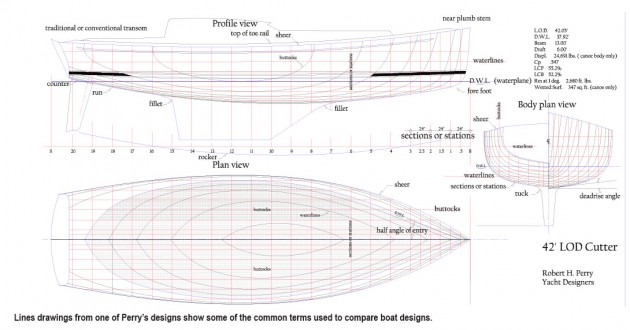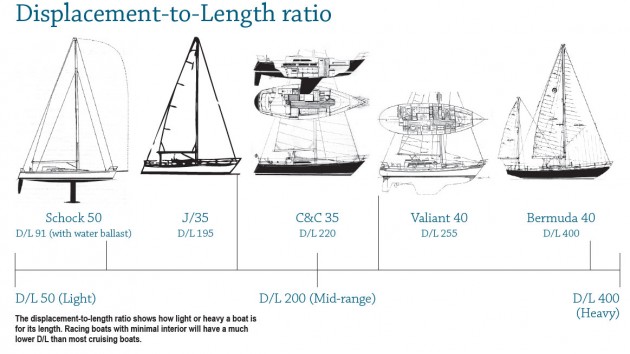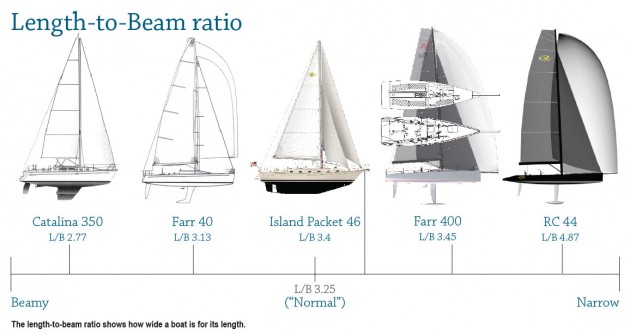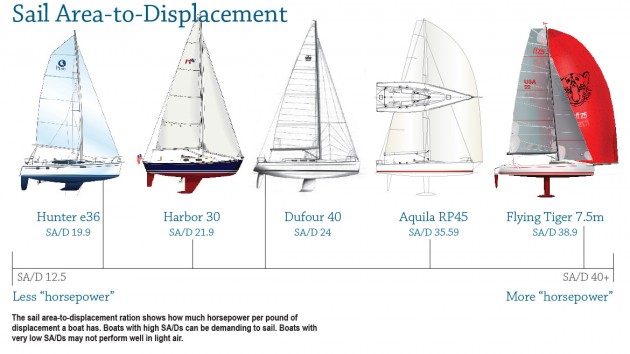Comparing boats
Bob Perry tells how to use design characteristics to compare boats before you sail them
I have now been doing the design reviews for SAILING Magazine for more than 35 years. I have had the pleasure of looking at a lot of new designs, around 1,600. I am so comfortable with the review process that I forget that many readers may be relatively new to sailing and they may not have a good grasp of the terminology I frequently use and how you can use that information to compare boats. When I write my reviews, I'm basing them on the design, not the actual boat. I don't sail each boat and in fact some of the designs I review are never built. I limit myself to discussing design features and not build quality. I can deduce much of a boat's sailing personality from the design and with a little practice and understand of how certain design features affect performance you will better understand the difference in designs.
Displacement-to-Length ratio (D/L)
 I first discovered this ratio when I was in high school and Ted Brewer used it in an article. I was staying home one day, sick with the flu and I grabbed my slide rule and a big stack of yachting magazines and began calculating D/Ls. The formula is simple: displacement in long tons (2,240 pounds equals 1 long ton) divided by 1% of the waterline cubed. This will tell us how heavy or light a boat is for its length. D/Ls will fall in a range from 50, very light, to 400, very heavy. Modern materials like carbon fiber have made it possible to build very light boats so while "very light" 35 years ago may have meant a D/L of 125 today D/Ls under 100 are fairly commonplace. I used to use a D/L of 250 to mark the middle of the range but today I think a D/L of 200 is probably more accurate to define the middle. Obviously racing boats with minimal interiors and high tech structures will have the lowest D/Ls while cruising boats with all their gear, extensive accommodations and stout construction will have higher D/Ls.
I first discovered this ratio when I was in high school and Ted Brewer used it in an article. I was staying home one day, sick with the flu and I grabbed my slide rule and a big stack of yachting magazines and began calculating D/Ls. The formula is simple: displacement in long tons (2,240 pounds equals 1 long ton) divided by 1% of the waterline cubed. This will tell us how heavy or light a boat is for its length. D/Ls will fall in a range from 50, very light, to 400, very heavy. Modern materials like carbon fiber have made it possible to build very light boats so while "very light" 35 years ago may have meant a D/L of 125 today D/Ls under 100 are fairly commonplace. I used to use a D/L of 250 to mark the middle of the range but today I think a D/L of 200 is probably more accurate to define the middle. Obviously racing boats with minimal interiors and high tech structures will have the lowest D/Ls while cruising boats with all their gear, extensive accommodations and stout construction will have higher D/Ls.
Rocker
I use the term "rocker" to describe the fore and aft curvature of the hull's canoe body below the waterline. If you have a boat with a low D/L, say 70, you will have very little rocker. But as the displacement grows the amount of rocker will increase. Boats with D/Ls above 320 will have a lot of rocker. I think the problem with a lot of rocker is that the typical heavy boat with excessive rocker will be loaded in the ends and this can make for a boat that is prone to hobbyhorsing. A boat with a more flat rocker is not likely to hobbyhorse. But it is likely to slam. Heavy boats seldom slam. Light boats can slam hard on the wind with any waves or chop. Also the light boat with minimal rocker will most likely be a faster boat so that increases the tendency to slam or pound.
Turn of the bilge and deadrise
These two terms go together. They describe the general sectional shape of the hull. Deadrise is measured in an angle from horizontal and indicates how much "V" there is the hull shape at centerline. A boat with lots of deadrise will have a deeply V-ed hull shape. Many modern boats have zero deadrise and actually go tangent at the centerline resulting in an almost flat bottom. Heavy boats are more likely to have more deadrise while boats with low D/Ls are more likely to have almost no deadrise. I like some deadrise in cruising boats because it makes for a natural bilge sump. I also like some deadrise at the transom to help prevent waves from slapping hard up against the underside of the transom when you are at the dock or anchored.
Turn of the bilge is a term used to indicate the area where the bottom of the hull meets the topsides. A boat with a lot of deadrise can be said to have "slack bilges." A boat with little deadrise will most probably have a "firm" turn to the bilge. Boats with slack bilges generally have less initial stability than boats with a firm turn to the bilge. But having slack bilges can give a boat better ultimate stability. There are lots of variable so I am speaking here in general terms.
Length-to Beam ratio (L/B)
 L/B is an easy one. I take LOA, length over all, and divide it by maximum beam. You get a range of numbers from 2.8, indicating a beamy boat, to 4.00 or more indicating a narrow boat. Most of today's series built cruiser-racer types run around 3.2 down to 2.85. I consider around 3.25 to be today's "normal." Of course whether the boat has extended overhangs or no overhangs at all will have a big effect on this ratio so it's not entirely reliable. Overhangs on a 40-foot LOA boat can be as much as 10 feet or as little as 3 feet or less. Over the years I have played with ratios for comparing the beam at the transom to max beam but again overhang differences aft have such a big effect on a ratio like this that I gave up. It probably would be better to calculate L/B using the DWL (design waterline) and the BWL (beam at waterline). But I do not always have access to the BWL figure.
L/B is an easy one. I take LOA, length over all, and divide it by maximum beam. You get a range of numbers from 2.8, indicating a beamy boat, to 4.00 or more indicating a narrow boat. Most of today's series built cruiser-racer types run around 3.2 down to 2.85. I consider around 3.25 to be today's "normal." Of course whether the boat has extended overhangs or no overhangs at all will have a big effect on this ratio so it's not entirely reliable. Overhangs on a 40-foot LOA boat can be as much as 10 feet or as little as 3 feet or less. Over the years I have played with ratios for comparing the beam at the transom to max beam but again overhang differences aft have such a big effect on a ratio like this that I gave up. It probably would be better to calculate L/B using the DWL (design waterline) and the BWL (beam at waterline). But I do not always have access to the BWL figure.
Buttocks and waterlines
Buttocks are vertical cuts running longitudinally through the hull parallel to the centerline. Boats with low D/Ls and minimal rocker will have flatter buttocks than heavy boats with lots of rocker.
Waterlines are horizontal cuts taken longitudinally through the hull parallel to the DWL, Design Waterline. Waterlines can go hollow in the entry area to give a boat a sharper "angle of entry." The angle of entry is measured in plan view from the centerline and usually written as "half angle of entry" as only one side of the hull is measured.
Stations
Designers will break down the hull into equal sections starting usually at the cutwater where the DWL intersects the profile of the stem. That first station will be Station 0. The last station, Station 10 will be where the stern profile, call it the counter or run, cuts through the DWL. I jokingly call this the "buttwater." So when I say Station 4 I am referring to a position 40% aft of Station 0 at the cutwater. You can break down a hull into as many stations as you like and with computers doing all the calculations it's not important anymore to have 10 stations. But when designers chat they will usually discuss the locations of things relative to the ten station breakdown. For instance, "The mast is located at Station 4."
Prismatic Coefficient (Cp)
This is a tough one because to accurately calculate the "Cp" you need numbers that are never included in the promotional specs and some designers don't even want you to know what the actual prismatic is. Think of it as the relationship of volume in the middle of the boat compared to the volume in the ends. Prismatics range from .51 to around .56. Consider .54 textbook "normal." A low prismatic means that the ends are fine and the boat is easily driven but will have low top hull speed. This is what you want for good light air performance. A high prismatic means the boat has a lot of volume in the ends and will be harder to push through the water but it will have a higher hull speed. You want a high prismatic if you are designing a boat for heavy air or surfing conditions. If you want a more detailed explanation of prismatic coefficient or any of these terms I suggest Steve Killing's excellent book Yacht Design Explained. It's the best book available on the rudiments of yacht design.
Sail Area-to-Displacement ratio (SA/D)
 I use this ratio to indicate how much "horsepower" per pound of displacement a boat has. The formula is simple: Sail area in square feet divided by the displacement in cubic feet to the two-thirds power. SA/Ds will range from as low as 12.5 to as high as 40 or more today. Thirty-five years ago SA/Ds ranged from 12.5 to around 21.00, maybe 22.00. But the fastest boats today carry huge rigs and even mom-and-pop production cruising boats will usually have SA/Ds around 20.00. It sounds nice to have a high SA/D but it can make for a boat that is demanding to sail and needs reefing early. But if your SA/D drops down under 15.00 you are approaching motorsailer proportions and you will give up light air performance.
I use this ratio to indicate how much "horsepower" per pound of displacement a boat has. The formula is simple: Sail area in square feet divided by the displacement in cubic feet to the two-thirds power. SA/Ds will range from as low as 12.5 to as high as 40 or more today. Thirty-five years ago SA/Ds ranged from 12.5 to around 21.00, maybe 22.00. But the fastest boats today carry huge rigs and even mom-and-pop production cruising boats will usually have SA/Ds around 20.00. It sounds nice to have a high SA/D but it can make for a boat that is demanding to sail and needs reefing early. But if your SA/D drops down under 15.00 you are approaching motorsailer proportions and you will give up light air performance.
I use the standard rig dimensions of I,J,E and P for the sail area. This is valid most of the time and in the past worked well. I don't count any headsail overlap and I generally don't count any mainsail roach. But today we have modern high-performance boats and many multihulls with exaggerated mainsail roach and even square top mainsails. In those cases I use all the area of the mainsail. If the boat is cutter rigged I do not use the area of both the jib and the staysail. I still just use the base of the fore triangle, J, and the height of the headstay, I for the fore triangle area. You do see from time to time manufacturers trying to fudge up their SA/D numbers by counting the area of all the sails in a cutter rig. I think if you are comparing these ratios the key is to be consistent with how you calculate them.
This article just touches on some of the more frequent terms I use in the reviews and how you can use them to help you understand how a boat may perform. I may, in the future, start adding more definitions within the reviews. But for now just make sure when you raise the womper that your flugworts are not tangled around the Benson post because you could easily shear your Finnigan pins.

Comments